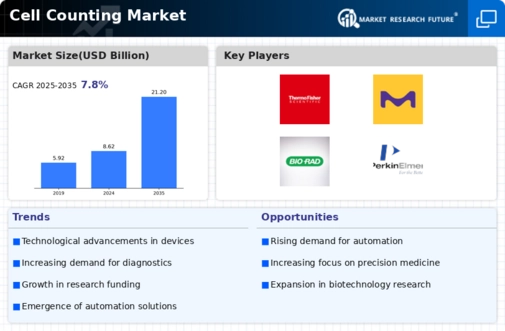Increasing public-private investments and funding in stem cell-based research impact the growth of the cell counting industry positively.
Cell counting is one technique for counting cells in the life sciences, such as medical diagnosis and therapy. To preserve and strengthen their positions in the market, the companies that operate in it adopt organic and inorganic growth tactics. The market is expanding thanks to the rising financing for stem cell-based research.
The increased need for biologics for treating chronic diseases is one factor driving the market's rise. Managing cell concentration in biologics with spectrophotometers and flow cytometers throughout the development of these products improves the market's growth possibilities. The COVID-19 made a substantial impact on market growth. Based on an individual's genetic profile, personalized medicine seeks to provide personalized treatments.
Furthermore, sophisticated cell-counting devices are becoming increasingly popular among key industry competitors due to their wide range of applications and workflow simplicity. Devices that count cells are essential for assessing patient samples and selecting the best treatment plans. The growing emphasis on customized medicine drives the worldwide need for cell-counting devices.
The prevalence of the target diseases, such as diphtheria, HIV, measles, chronic conditions like cancer, additional blood disorders, automated hematology analyzers, and high-throughput flow cytometry are both boosting the market's growth. The market has expanded due to technological advancements in cell counting consumables and equipment that have improved product introductions and adoption.
As a result, it is projected that factors including the increasing prevalence of chronic diseases, advancing technology advancements, and recent product launches within the cell counting industry will fuel the industry's growth. However, the high cost of complicated cell counting machinery and hematological analyzer product recalls may restrain market expansion.
The expanding studies and development activities in the biological sciences, biotechnology, and pharmaceuticals drive the demand for cell counting equipment. Various research applications, such as the study of stem cells, drug discovery, and regenerative medicine, depend on these devices, which is driving market expansion. As lymphopenia and eosinopenia were possible COVID-19 indications, the adoption of cell counting instruments significantly increased during the pandemic.
More people seek medical care for oral disorders like atrophic glossitis as knowledge of oral health and its connection to general health grows. The demand for treatment alternatives is fueled by the discovery and diagnosis of cases of atrophic glossitis, made possible by advancements in diagnostic methods and the availability of healthcare services.
The increasing demand for precise and efficient cell counting technologies is reshaping the landscape of biomedical research and clinical diagnostics, as researchers seek innovative solutions to enhance accuracy and streamline workflows.
National Institutes of Health (NIH)





